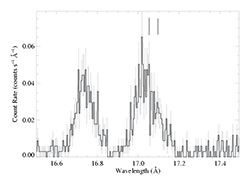Fe XVII 17.051, 17.096 Angstroms
summary of the data
Note: We fit only the MEG data. There are 402 MEG counts in the spectral region we fit (and plot below). The two lines are heavily blended, which ultimately makes the constraints we derive on the profile parameters somewhat weak.
View the spectral region near the line: MEG. The Fe XVII line at 16.78 A is separated from the two Fe XVII lines just longward of 17 A, but they are very strongly blended. The ratio of the line strengths is governed by atomic physics, and should be close to unity, but there is some degree of uncertainty, both due to uncertainties in the atomic rates but also due to mild temperature sensitivity of the line ratio. Below, we show the spectral region around these lines, with the lab rest wavelengths of the two components indicated.

|
Given the uncertainty in the relative line strengths, we fit two-profile plus continuum models (continuum well-determined on 17.2:17.4) with relative normalizations free, and then with the 17.096/17.051 normalizations fixed at 0.8, 0.9, and 1.0. As can be seen in the logs of the fits of non-porous and isoporous models, none of these models provided especially good fits (Monte Carlo rejection probabilities in the low 90%s for all of them), and not much preference for any one range of normalization ratios is seen.
Overall, taustar values between 2 and 3 are favored, with relatively little sensitivity to the assumed (or not) relative normalizations. In fact, for non-porous models, taking the normalization ratio = 0.9 case, we've got taustar=2.52 (1.88:3.22); uo=0.682 (0.553:0.99). Taking the maximum extent of the confidence ranges for the 0.8 and 1.0 relative normalization cases, too, we've got 68% confidence ranges of (1.72:3.40) and (0.550:0.99) for taustar and uo, respectively.
For completeness, we show the non-porous model fits, with various normalization ratios, and one isoporous model fit.
Back to main page.
last modified: 6 July 2008